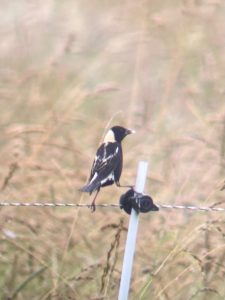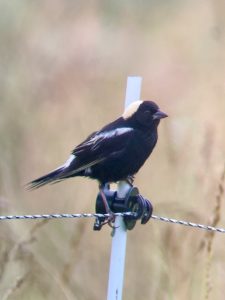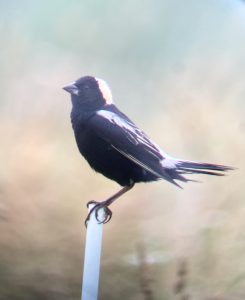Mathias Bitter, a student at Lincoln Sudbury Regional High School surveyed Farm Meadow this summer for bobolink activity. The project was overseen by naturalist Norman Levey. Farm Meadow is located near Lincoln Station in South Lincoln and can be accessed from the trailhead at the far end of the paid commuter lot. Farm Meadow is a town-owned property with a conservation deed and is currently used by Codman Farm for livestock raising (cattle and chicken).
Mathias writes: “Bobolinks are a small songbird in the blackbird family that exhibit bright plumage and a unique, bubbling song. For a long time these showy little birds have nested in hay fields around Lincoln, MA. However, in recent years, more and more hay fields have been converted into pastures for livestock, leading to the Bobolink’s decline. One of the last of the Bobolink’s nesting sites in Lincoln is a field called Farm Meadow. This field is used in part by the cattle but an agreement was made with Codman Farm to keep a section of the field protected for the Bobolinks.
For years this breeding population has been monitored by Norman Levey, a Lincoln resident and local naturalist who handed the project off to me this year. I’ve continued this conservation effort by visiting the Bobolinks regularly for the past four months, allowing me to see much of the breeding cycle, from displaying males in May to parents visiting the nest in June and July.
I was able to locate one nest and photograph the male bringing food back to his mate. Although this was a magical experience, the small groups of 2-4 Bobolinks seen this year pale in comparison to the 50+ Bobolinks that gathered at Farm Meadow just ten years ago, or the over 100 that were seen thirty years ago. Declining species such as the Bobolink need volunteers monitoring their nesting to recognize possible dangers that they face and to notice trends in their population. It is important that natural areas like Farm Meadow are monitored and protected so that Bobolinks can continue to thrive in Lincoln.”
LLCT thanks Mathias for his effort this summer and the important data he collected. LLCT hopes that continued monitoring of the field will help inform land management practices that support agricultural goals and create attractive habitat to these grassland birds.




